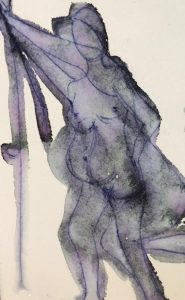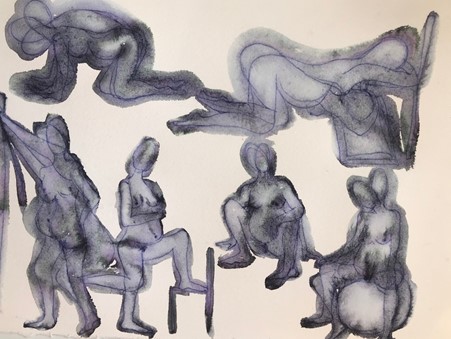Just as there are many positions to get a baby in, there are many positions to get a baby out – in both cases the most important question to ask is – what feels good?!
Lying on the back is still the most common position women give birth in. To be honest this blows my mind. While this position is ‘convenient’ for care providers and is the way they have been ‘trained’ to monitor birth and perform their ‘duties’, it is probably the worse position for the woman to be in to bring her baby into the world. While I will acknowledge there may be some high risk cases where a supine position may be necessary or helpful, and also that interventions such as epidurals and some foetal monitoring devices make moving far more difficult-to-impossible, for the vast majority of women this position is completely counterproductive and may even lead to an increased likelihood of medical intervention. Being flat on the back, or semi-reclined we are working against gravity and our own physiology. As women giving birth and supportive care givers in the birth space let’s learn about the human body, let’s take our power back when it comes to our birth and our bodies and let’s get moving!
Getting into position – the pelvis.
In childbirth we want to be in ‘sacral- flexible’ positions. The movement available within the pelvis is astonishing and a change in position can result in an increase of up to 30% of available space in the pelvis. The coccyx and sacrum can flex outwards from the pressure of the baby’s head and having constant counter pressure on these bones (from the solid surface of a bed) will prevent this movement happening. Upright birth positions also have many benefits of utilising gravity to support and assist the baby to move down into the pelvis, to have more space to move into a more optimal position and can create more ease and reduce discomfort for the mother. Being upright can also impact the blood flow, reducing the risk of compression of the mothers aorta and increasing the oxygen supply to baby. Yay! Let’s go through some of the options available and the benefits.
Hands and Knees (all fours)
This position can be on the floor or bed, or anywhere the mother feels stable and supported by a firm, even surface. All fours is a great position that takes all pressure off the back. This position is very active and stable. The woman can press into the four points of contact with the floor and use her strength to take the weight off the centre of her body, allowing her to feel lighter and freer in the pelvis. She can easily move in many different ways and directions in this position, her pelvis is completely unrestricted, and she is free to respond to the impulse of how her body might wish to rock, stretch or bend. This position allows for the pelvis to easily flex and extend, tilting backwards and forwards, which can feel good for the mother and is offering maximum space for the baby. This position is also good for support people to easily access the woman’s lower back for counter pressure, rubbing, hip squeezes and massaging the muscles around the sit bones. Potential downside? Your arms (or knees) may get tired (or sore) after a while. Place pillows or something soft under the knees if necessary.

Kneeling, leaning forward
If you love the all fours position, but your arms get tired, another option to try would to still be on your knees, but resting your arms over something – the edge of the bed, a chair, a ball, a pile of pillows or have your partner support your upper body. This will have all benefits of the previous position, such as no pressure on the back, freedom to rock, move, flex and tilt your pelvis and also easy access to your lower back for another person, but with the added support and comfort. It is slightly less ‘active’ and slightly more ‘resting’ as you can ‘let go’ more in your upper body and this can be good if the mother is finding the position is serving her labour progression, but is also feeling tired.

Standing
Standing is an underrated position. We have gravity working its magic, we can walk, dance, sway our hips, we can press into a wall, we can hold onto something from above – a rope or rebozo (knotted over a door). We are free. Standing is such a versatile position, why not just get up and walk around? Feel yourself on your feet, feel your pelvis moving in three planes of direction as you walk. It is so important women can feel free to move however their body wants to move and be in any position their body feels to be in during childbirth. Getting up and standing can put you in that position – everything is possible – where do I want to go now? Do I want to go to the shower, the toilet, change the music, have a sip of water, hug my partner, circle my hips? Whilst standing is a ‘position’ in itself I feel the great benefit of standing is the feeling of freedom, choice and potentiality. I can move, I can choose. Holding something from above is also a fantastic position, especially in the final stages of active labour and transition as the intensity and pressure accumulating in the pelvis can be so strong that literally taking the weight of your feet and supporting yourself using your upper body strength can can help immensely as your pelvis doesn’t have the extra pressure of supporting your body weight.

Asymmetrical kneeling, walking, lunging
This one is something to keep in mind, especially if labour is slowing, or even to help kick-start things. In labour we always want to be focused primarily on ‘where is baby?’ This is far more helpful than focusing on what the cervix is doing. Sometimes, and especially if your baby is in the posterior position, doing some movement or getting in a position that is asymmetrical can be just what the baby needs. It will help open the pelvis even more on one side, which along with the gentle force of gravity, might give the baby just that fraction of extra room it needs to move into an optimal position – whether that be engaging fully into the pelvis, moving down or rotating during labour. This position could be a variation of all the ones mentioned before, but you would have one leg in a position that opens one of the hips bones outwards or upwards- for example, on all fours or kneeling, one leg would be bent with the foot on the floor or standing on an uneven surface (a curb or raised surface). This technique of ‘curb walking’ is usually used in very early labour or as a way to potentially induce/ progress labour. Lying on your stomach, one knee bent upwards and shoulders open across the bed can be another helpful asymmetrical position for posterior babies.

Squatting
An age-old position, seen in many ancient depictions of women in labour – the squat. This position has great benefits as it puts your body in beautiful alignment. It is important to know, however, that this is achieved with the feet being parallel (not with the toes facing outward in a ‘v’ shape which can reduce the pelvic outlet) and so it could be helpful to practice this position during pregnancy (which will be also be a benefit to labour). With the feet parallel and the spine straight (hello flexibility) our pelvis and uterus are tilted forward and the baby comes into graceful alignment with the cervix and vagina. This position also helps relax and stretch the muscles the pelvic floor, it can strengthen the intensity of the contractions (speeding up labour) and also feel quite relieving and opening in the lower back. Like I said – please practice this position! You might also want to find support in this position, a partner behind you holding under your arms, resting your back against a wall or ball, someone or something in front of you to hold onto.

Sitting
Sitting on a fit ball, a CUB (a specific inflatable birth chair), a regular chair, or whatever is available are also great. It can help relax and take pressure off the pelvic floor, you can sit with your legs wide open, creating space in the pelvis and relieving the lower back in an active, supported position. If you are on a ball (making sure it is the right size and your knees aren’t higher than your pelvis) you can bounce, rock, circle and generally move in a flowing supported way however feels good for you.

Positions! Know them, love them, use them, make up your own – variety is the spice of life! Listen to your body and your baby and give yourself the best chance of an uncomplicated and positive birth experience.

(All images by Anna Cocks, copyright 2021)
My name is Anna Cocks and I am a Doula who has trained with Vicki Hobbs at the Doula Training Academy. If you would like more information about my doula services please contact me:
Business Name:
Creative Magic – Doula services
Phone:
0404 914 419
Email:
[email protected]
Facebook:
https://www.facebook.com/Creative-Magic-Doula-Services-106842984793062
Instagram:
https://www.instagram.com/creative.magic.doula/
Website:
www.creativemagicdoulaservices.com

